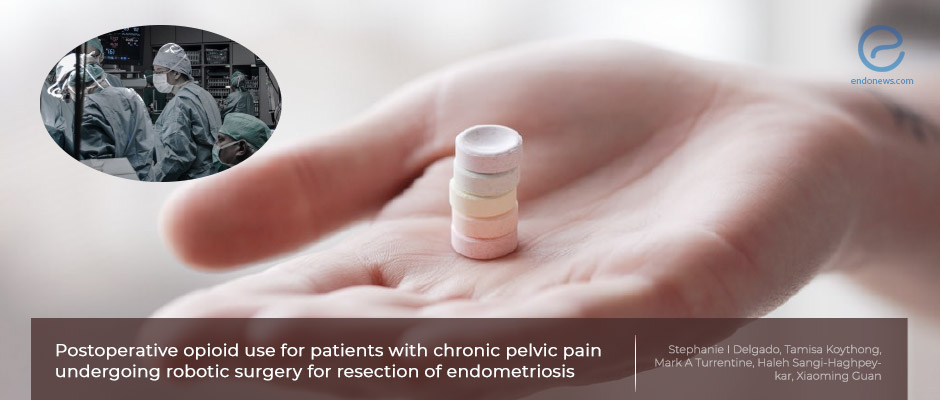Postoperative Opioid use after Robotic operations for endometriosis, compared to non-endometriosis
Aug 11, 2021
Patients undergoing robotic surgery for endometriosis necessitate over two times as many opioids postoperatively as patients without endometriosis and have a higher perceived postoperative pain
Key Points
Highlights:
- Opioids are important to reduce pain and improve patients’ life quality in women who underwent robotic endometriosis surgery, and their use differ from the routine minimally invasive postoperative treatments.
Importance:
- The present study aimed to clarify the beneficial effects of opioid drugs in patients who underwent robotic endometriosis excision.
- Furthermore, this study investigated the amount of opioid use following robotic endometriosis surgery compared to non-endometriosis gynecologic surgeries.
What's done here:
- The study was performed between January 2019 and March 2020, in a retrospective manner, and patients’ charts who underwent robotic surgery for endometriosis and benign conditions were reviewed.
- Patients who underwent open surgery and patients who were taking opioids for chronic pelvic pain were excluded from the study.
- Preoperative characteristics of patients, operative and postoperative outcomes were recorded. Also, the postoperative pain scale (from 0 to 10, best to worst) and amount of opioid use were recorded for the postoperative first 3 weeks follow-ups.
- Patients were divided into two groups according to having surgery for endometriosis and other benign conditions. Also, patients who underwent endometriosis surgery were categorized into two groups in case of having a hysterectomy. Groups were compared according to pre-operative, operative, pain status, and opioid requirement.
Key Results:
- Overall 158 patients met the study inclusion criteria, and 119 patients underwent robotic endometriosis surgery, 39 underwent robotic surgery for benign diseases.
- The mean age was younger and the mean BMI was significantly lower in patients who underwent robotic endometriosis surgery.
- Estimated blood loss was higher in patients who underwent robotic surgery for benign conditions.
- Multivariate regression analysis revealed that patients underwent robotic endometriosis surgery had significantly higher postoperative pain and required longer opioid treatment.
- The postoperative opioid requirement was not affected by having a hysterectomy in patients with robotic endometriosis surgery.
Limitations:
- Relatively small numbers of patients and outcomes from a single center, absence of long-term pain scores and opioid needs are limitations.
- The cost of drug use following robotic surgeries for endometriosis and benign conditions are not calculated.
Lay Summary
Endometriosis is a common disease in patients of fertile age, and many patients require surgery. Robotic surgery is accepted as a minimally invasive method in the management of endometriosis and other benign conditions. However, postoperative pain status and the best pain relief option after robotic endometriosis surgery have not been optimized yet.
Delgado and colleagues analyzed the post-operative pain status and opioid requirement in 119 patients who underwent robotic endometriosis surgery and compared the results with those from 39 patients who underwent robotic surgery for benign diseases.
Authors found that patients with robotic endometriosis surgery had significantly higher postoperative pain scores in the first and second weeks, but not in the third week following surgery. Authors also stated that the time required for opioid use was significantly longer in endometriosis patients. The postoperative opioid requirement has not been affected by having a hysterectomy in patients with robotic endometriosis surgery.
The authors emphasized that physicians should be aware of the differences in the time and amount of opioid use between endometriosis and non-endometriosis surgeries, even though both are minimally invasive procedures with the same implementations.
This interesting paper was published in the 2021 June issue of the "Journal of Robotic Surgery".
Research Source: https://pubmed.ncbi.nlm.nih.gov/34075544/
robotic endometriosis surgery postoperative opioid use

